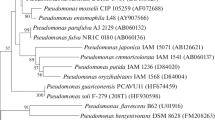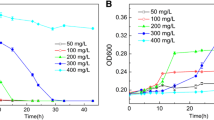Abstract
A fast-growing Pseudomonas fluorescens CAS102, isolated by enrichment technique from polluted soil, effectively utilized morpholine as the energy source. The strain was able to grow in high concentrations of morpholine but accumulation of ammonia inhibited its growth and complete mineralization. The molar conversion ratio of morpholine to ammonia was 1:0.82. The organism harboured a single, multiple antibiotic- and heavy metal-resistance 140kb plasmid which was resistant to curing. Transformation studies showed that the morpholine degradative phenotype was expressed only in Pseudomonas putida and not in Escherichia coli. Growth studies on different degradative intermediates of morpholine suggested that plasmid-encoded genes were involved in the heterocyclic ring cleavage and the remaining reactions were mediated by chromosomal genes.
Similar content being viewed by others
References
Alexander, M. 1973 Nondegradable and recalcitrant molecules. Biotechnology and Bioengineering 15, 611–647.
Berry, D. & Kropinski, A.M. 1986 Effect of lipopolysaccharide mutations and temperature on plasmid transformation efficiency of Pseudomonas aeruginosa. Canadian Journal of Microbiology 32, 436–438.
Birnboim, H.C. & Doly, J. 1979 A rapid alkaline extraction procedure for screening recombinant plasmid DNA. Nucleic Acids Research 7, 1513–1523.
Brown, V.R. & Knapp, J.S. 1990 The effect of withdrawal of morpholine from the influent and its reinstatement in the performance and microbial ecology of a model activated sludge plant treating a morpholine containing influent. Journal of Applied Bacteriology 69, 43–53.
Brown, V.R, Knapp, J.S. & Heritage, J. 1990 Instability of morpholine degradative phenotype in mycobacteria isolated from activated sludge. Journal of Applied Bacteriology 69, 54–62.
Buchanan, R.E. & Gibbons, N.E. 1974 Bergey's Manual of Determinative Bacteriology. 8th edn. Baltimore: Williams and Wilkins.
Casse, F., Boucher, C., Julliot, J.S., Michel, M. & Denarie, J. 1979 Identification and characterization of large plasmids in Rhizobium meliloti using agarose gel electrophoresis. Journal of General Microbiology 54, 229–240.
Cech, J.S., Hartman, P., Slosarek, M. & Chudoba, J. 1988 Isolation and identification of a morpholine-degrading bacterium. Applied and Environmental Microbiology 54, 619–621.
Dilworth, M.J. & Thorneley, N.F. 1981 Nitrogenase of Klebsiella penumoniae: Hydrazine is a product of azide reduction. Biochemical Journal 193, 971–983.
Knapp, J.S., Callely, A.G. & Mainprize, J. 1982 The microbial degradation of morpholine. Journal of Applied Bacteriology 52, 5–13.
Maniatis, T., Fritsch, E.F. & Sambrook, J. 1982 Molecular cloning: a laboratory manual. Cold Spring Harbor, NY. Cold Spring Harbor Laboratory.
Mazure, N. & Truffaut, N. 1994 Degradation of morpholine by Mycobacterium aurum MO1. Canadian Journal of Microbiology 40, 761–765.
Mjos, K. 1978 Cyclic amines. In Kirk Othmer Encyclopaedia of Chemical Technology. Vol. 2 London: Wiley Interscience. pp. 395–408.
Schuman, J.D., Zottola, E.A. & Harlander, K. 1989 Preliminary characterization of a food-borne multiple-antibiotic-resistant Salmonella typhimurium strain. Applied and Environmental Microbiology, 55, 2344–2348.
Singer, G.M. & Lijinsky, W. 1976 Naturally occuring nitrosatable compounds. II Secondary amines in tobacco and cigarette smoke condensate. Journal of Agricultural and Food Chemistry 24, 553–555.
Swain, A., Waterhouse, K.V., Venables, W.A., Callely, A.G. & Lowe, S.E. 1991 Biochemical studies of morpholine catabolism by an environmental mycobacterium. Applied Microbiology and biotechnology 35, 110–114.
Waterhouse, K.V., Swain, A. & Venables, W.A. 1991 Physical characterization of plasmids in a morpholine degrading mycobacterium. FEMS Microbiology Letters 80, 305–310.
Author information
Authors and Affiliations
Rights and permissions
About this article
Cite this article
Chandrasekaran, S., Lalithakumari, D. Plasmid-assisted morpholine degradation by Pseudomonas fluorescens CAS 102. World Journal of Microbiology and Biotechnology 14, 7–10 (1997). https://doi.org/10.1023/A:1008855912907
Issue Date:
DOI: https://doi.org/10.1023/A:1008855912907




